I have a problem with to-do lists. I love them. I gleefully make long, epic lists of my plans for a day or weekend. Sometimes I even write things on my list that I’ve already done just so I can experience the joy of crossing it off. Other people do this, too. Right? Maybe?
 Unfortunately, sometimes my lists spiral into what my husband calls my “ten pounds” problem. He teases me that I insist on trying to cram 10 pounds of fun into a five-pound bag. Often when I tell him my plans for a weekend, he’ll roll his eyes and say, “Sounds like ten pounds to me.”
Unfortunately, sometimes my lists spiral into what my husband calls my “ten pounds” problem. He teases me that I insist on trying to cram 10 pounds of fun into a five-pound bag. Often when I tell him my plans for a weekend, he’ll roll his eyes and say, “Sounds like ten pounds to me.”
But this past Friday—the second Friday of the school year—when I dragged home my bag filled with 85 AP English essays, 85 AP English quizzes, 58 ELA-10 narratives, 58 ELA-10 quizzes, and 58 ELA-10 constructed responses, I realized that I, for once, might actually have 10 pounds of fun in my bag. And I was not happy about it.
The Paper Load
It was the second week of school, and I was already overwhelmed.
Some of it was simply a product of a busy first two weeks back: Curriculum Night, activities for my own  kids in the evenings, first week exhaustion. Those pressures will ease up as the year progresses, and things will get easier. But some of the pressures will not go away.
kids in the evenings, first week exhaustion. Those pressures will ease up as the year progresses, and things will get easier. But some of the pressures will not go away.
Yet one of the downsides of this job, which I adore, is the paper load. Often, it is easiest to assess students’ comprehension of a text by having them write about it. And students only become better writers if you give them specific feedback on their writing.
As I slogged through the stacks this past weekend, I resolved to be smarter this year. I’m still committed to giving consistent, quality feedback, but I need to figure out how to lighten the load in my 10-pound bag a bit.
Here are some of the things I’m hoping to try this year and some of my concerns:
- Reading conferences. Some of the assessments I graded this weekend could have been easily replaced with a simple conversation. An individual reading conference would give me the opportunity to connect with my students one on one and ask some pointed questions about their reading. I created this Reading Conference Prep sheet to help them prepare for our reading conferences.
- My concern: How will I make this work time-wise? What will the other 28 students do while I’m conferencing? Twenty-nine individual conferences will likely take three days of class time. I will have to use this strategy carefully and plan independent activities for the students. Also, it’s not something I’ll be able to do that often. Still, I think it’s a worthwhile “sometimes” solution.
- Small-group discussion. This is a strategy I have used for several years now and I will need to employ it more this year. I divide my students into small groups and send them out in the hallway for a 10-minute discussion. They videotape it and I can grade it later using a rubric like this.
- My concern: What about my shy students? Will I truly see what they know about the text in this setting? This can’t be the only way I gauge understanding, but it is valuable to assess speaking and listening. That’s a whole strand of the Common Core!
- Group comments, analysis, and revision. This is a strategy that I used this weekend. As I tackled the third stack of writing assignments, I realized I was writing the same comments over and over. Enough. Why was I working so hard when they were all struggling with the same thing? I stopped writing comments and scored the essays on a 4/3/2/1 scale. I pulled some student samples of 4-level writing to use as models. In class we examined the models and figured out the characteristics of each level of writing. When I handed back the scored, comment-less papers, I had the students tell me what was missing from their writing and then revise to make them better.
- My concern: Does this even save time? Realistically, no. I spent a lot of time prepping this lesson. Still, I think it was more useful than handing back papers littered with comments. The students were engaged in the revision process and, hopefully, it will pay off in future writing assignments.
None of these ideas are earth shattering or groundbreaking. Teachers have been doing these types of things for years. For me, though, I need to commit to finding a better balance between my desire to give quality, timely feedback with my need to not be overwhelmed by grading. As my husband constantly reminds me, there’s only so much room in a bag.
 Hattie Maguire is an English teacher and Content Area Leader at Novi High School. She is spending her fourteenth year in the classroom teaching AP English Language and Composition, English 10, Debate, and Practical Public Speaking. She is a National Board Certified Teacher who earned her BS in English and MA in Curriculum and Teaching from Michigan State University.
Hattie Maguire is an English teacher and Content Area Leader at Novi High School. She is spending her fourteenth year in the classroom teaching AP English Language and Composition, English 10, Debate, and Practical Public Speaking. She is a National Board Certified Teacher who earned her BS in English and MA in Curriculum and Teaching from Michigan State University.

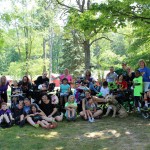 took a deep breath. I was excited to arrive after the two hour commute on a sunny Sunday morning. To say I wasn’t nervous would be a lie. I was about to embark on what I had heard was an incredible, yet challenging week of intense learning. I, along with eight Oakland County teachers and two of my Oakland Schools colleagues, would spend the next seven days together attending a Level II course in Literacy for Students with Significant Disabilities at
took a deep breath. I was excited to arrive after the two hour commute on a sunny Sunday morning. To say I wasn’t nervous would be a lie. I was about to embark on what I had heard was an incredible, yet challenging week of intense learning. I, along with eight Oakland County teachers and two of my Oakland Schools colleagues, would spend the next seven days together attending a Level II course in Literacy for Students with Significant Disabilities at 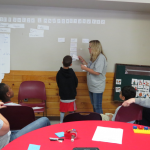
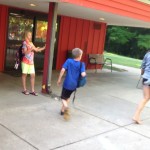
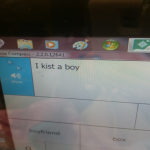
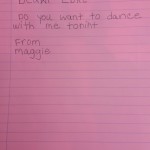

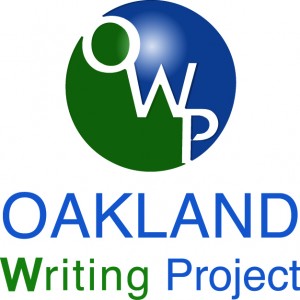 The
The 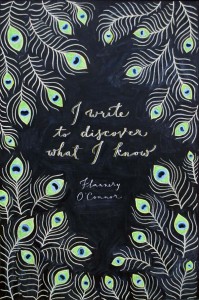
 Theme dragons…these beasts are so fierce. They can linger, haunt a reader. Shy away from a craft dragon–I struggle with stream of consciousness–and probably it won’t make a difference in your life, just avoid it. Fear of theme dragons is something different.
Theme dragons…these beasts are so fierce. They can linger, haunt a reader. Shy away from a craft dragon–I struggle with stream of consciousness–and probably it won’t make a difference in your life, just avoid it. Fear of theme dragons is something different.  Asking students to confront theme dragons often means asking them to expose their fears, weakness, doubts and prejudices to their peers and then be evaluated on that battle. What could be more terrifying? But that is exactly what we ask students to do when they read and write. When they are successful and make a connection to their audience it’s often because the writer has found a way to portray their voice. They write in ways that conveys a sense of themselves to an audience. I think that’s a function of voice, and it is what I want them to develop. In the next few weeks, I’ll be looking at and helping students with their college essays. I’ve done it for years and those topics don’t change, “Consider a time…” What the colleges are asking for is that the student pull out a dragon, fight it and hope that it’ll get them into college. That’s a high stakes fight and if it’s the first time a student has been asked to do it, I end up reading a lovely, generic travelogue that sounds nothing like the interesting, engaging complicated people in my classes. I need the dragons in my class. I need to find them, drag them into my students’ paths and help them give voice to the struggle.
Asking students to confront theme dragons often means asking them to expose their fears, weakness, doubts and prejudices to their peers and then be evaluated on that battle. What could be more terrifying? But that is exactly what we ask students to do when they read and write. When they are successful and make a connection to their audience it’s often because the writer has found a way to portray their voice. They write in ways that conveys a sense of themselves to an audience. I think that’s a function of voice, and it is what I want them to develop. In the next few weeks, I’ll be looking at and helping students with their college essays. I’ve done it for years and those topics don’t change, “Consider a time…” What the colleges are asking for is that the student pull out a dragon, fight it and hope that it’ll get them into college. That’s a high stakes fight and if it’s the first time a student has been asked to do it, I end up reading a lovely, generic travelogue that sounds nothing like the interesting, engaging complicated people in my classes. I need the dragons in my class. I need to find them, drag them into my students’ paths and help them give voice to the struggle. Rick Kreinbring teaches English at Avondale High School in Auburn Hills, Michigan. His current assignments include teaching AP Language and Composition and AP Literature and Composition. He is a member of a
Rick Kreinbring teaches English at Avondale High School in Auburn Hills, Michigan. His current assignments include teaching AP Language and Composition and AP Literature and Composition. He is a member of a